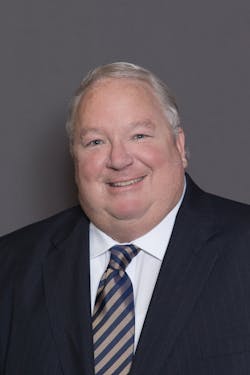Chicago Rockford International Airport (RFD) has undergone changes in recent years with addition of an AAR Corp. MRO and a nearly 50 percent surge in air cargo in 2017, which saw 1.4 billion pounds of cargo pass through the airport.
Airport Business spoke with Mike Dunn, executive director, Greater Rockford Airport Authority, to learn more about this growth and the challenges the airport faces going forward to meet current and future demands.
Airport Business: Rockford saw a 50 percent surge in cargo traffic in 2017. What is driving this growth?
Mike Dunn: For the last 20 years, we here at the airport have always recognized that we have a world-class facility 62 miles away from the Chicago market. We’ve always believed that sooner or later both the cargo airlines and the passenger airlines would find us and figure out that we could be a great alternative to Chicago O’Hare when trying to serve the Chicago market.
The real strong reasons for the increase is because that has now happened—we’ve been found by airlines both from the passenger side, but mostly from the cargo side at this point. They’ve now identified that planes can get into this airport, load or unload and have their product to distribution center in the Chicago market probably in most cases faster than they can get it off O’Hare.
Rockford for the last 30 years has been home to UPS. We’re the second largest air hub for UPS outside of Louisville. Their activity has increased significantly over the last two years. We’re also now home to Pinnacle Logistics, which is handling stuff here for ABX, ATI and Atlas.
AB: How will UPS’s recent plans to invest $15 million in its cargo facility at Rockford impact operations?
MD: We’re being told it’s going to significantly increase their operations. We’re working on a new ramp plan for UPS, which is about a $30 million expansion of the ramp on top of what they’re doing.
AB: How is the airport equipped to take on this additional traffic and cargo?
MD: As these carriers will say to us “flying the airplanes to your airport is one thing, having a place to park them and handle them is another.” The challenges for us — though I think we’ve met the challenges very nicely — is expansion of the infrastructure in terms of parking and building capacity. We’re now starting construction on a 120,000 square foot cargo building expansion, which more than doubles the size of the building. Keeping up on the capital investments for the needs of the cargo guys is always a challenge.
On the passenger side, we’re going through a $20 million expansion, rehab and remodeling of the existing terminal that has been there since 1984. We’re modernizing that with all sorts of improvements. We’ve added on 30,000 square feet onto the existing 50,000-square-foot terminal. Plus, the entire 80,000-plus-square-foot facility is now being remodeled and rehabbed. That building was originally built in 1984 to accommodate commuter aircraft, propeller airplanes, where passengers would walk in the front door, stay on the first floor, walk out and get on an airplane. We had to convert the second floor, which for all practical purposes was nothing but offices and restaurants into gate hold areas. We had to drop some jet bridges off those areas, we had to incorporate TSA into the building in 2001, so that building was never meant to do what it has been doing for the last 10 years, so it was due for an update.
AB: Your airport has garnered more than $61 million in federal funds in the past five years. How have you been able to successfully make your case for funding with lawmakers?
MD: First and foremost I’d give the credit to the FAA. We have a very strong relationship with the FAA and we’ve been able to tell them our story and they have accepted that story and agreed that Rockford could be and should be a great alternative or reliever airport to O’Hare. They have been very supportive. We also tell the same story and work the same communication system with our congressional folks in Washington and Senator Durbin, Congresswoman Bustos and Senator Duckworth have been extremely supportive of this airport.
AB: What additional air service is your community looking for?
MD: The one thing we’ve made a mistake on in the past is we’ve gone out and tried the revenue guarantees. That just hasn’t worked and we’re not pursing anything like that. The community would love to see continued growth in the nonstop jet service to places. We’ve got a great carrier here in Allegiant that really services five of the best vacation destinations in the country. It’s pretty hard on the passenger side to compete with O’Hare when you’ve got American, United and Delta there that offer business travel. We’re really not set up for nor do we pretend to be a business airport where you’d need the repetition of two, three, four flights per day to a destination. We’re not there yet and that’s a challenge.
AB: With recent media reports causing concerns about Allegiant in some communities, are you hearing concerns from your community as well given how big of a presence they have at your airport?
MD: None at all. They’re very big supporters of the airline. I think Allegiant would confirm that Rockford has one of their highest load factors. We’re continuously in the very hierarchy of the Allegiant system for load factor and looking down the road to future bookings, they look extremely strong. Allegiant has been a great corporate partner in this area, so we’re very supportive of Allegiant.
AB: Your airport started charging for parking in January. How has the public responded to the change and is it creating the revenues envisioned?
MD: It is creating the revenues we hoped for. We intentionally kept the price very low compared to other airports in the area and we’ve had no real negative blowback at all.
AB: With AAR’s new facility up and running, what kind of impact has the airport seen from the new facility? Is it living up to expectations?
MD: It has been extremely successful. It’s nice to see our airport with so many aircraft from major airlines here that are being worked on. Right across the street from the AAR facility, our community college, Rock Valley College, built a new training school for A&P mechanics. Historically they’ve been on the airport for about 30 years and they were producing 20 to 25 students per year graduating. We asked them to up that game significantly. They’ve gone from a 9,000-square-foot facility to a 40,000-square-foot facility and they’re now graduating about 125 students per year. The program is already booked for the next three semesters. These guys and girls can go walk across the street and work for AAR, which is moving along very successfully. It’s working exactly as planned.
AB: With the additional need for employees on the airport with expanded cargo, has this been a challenge to address as an airport with any staffing issues?
MD: Human resources is a current challenge to all industries and all sectors and all employers and we’re no different.
AB: With the failure of the state to take up a bill to expand the taxing district for airports in Illinois, how are you looking to proceeds to make sure the airport is receiving funding?
MD: The downward pressure on property tax revenue in Illinois and locally is very strong. A governmental authority like Rockford Airport, we have to continually find other revenue enhancements for the airport. The particular effort you’re referring to was really started with Bloomington airport and Quad Cities airport. Rockford joined in because we thought it was worthwhile. Rockford is located in Winnebago County and the airport is located in the city of Rockford. In Winnebago County, only about 40 percent of the county is contributing property tax wise to the airport. We take a position that the entire county should be supporting this airport. The entire county and region does benefit by the airport economically. If it were to go through the way it was proposed, the current 40 percent of the county who pays taxes to the airport their taxes would go down a little bit and the other 60 percent that would now be contributing would be contributing a very, very low amount.
AB: There has been a lot of political challenges in Illinois in recent years, but a budget was recently passed that got you $3 million in federal funding to upgrade the cargo apron and the terminal. Going forward, do you see any positive signs that things are going to get easier for airports in the state?
MD: We refer to Illinois as a pass through state. When you have a $3 million project from the FAA, that money goes through the state of Illinois Department of Aeronautics and then it comes to us. The state of Illinois will contribute 5 percent of the project or $150,000 and locally it’s $150,000. I believe personally that the state of Illinois clearly understands the importance of this airport to the state’s economic vitality and to the future growth of the state. I’m very comfortable in believing that the state will always be a good partner.





